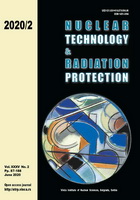
ANALYSING RADIONUCLIDE CONTENT IN SOIL SAMPLES AND RADIOLOGICAL RISKS IN THE CLAYEY MATERIAL SURROUNDING OF THE “ZBEGOVI” DEPOSIT, DONJE CRNILJEVO, SERBIA
Pages: 154-164
Authors: Sreten B. Ilić, Tatjana D. Golubović, Nataša D. Pajić, Mirjana M. Đurašević,
and Aleksandar B. KandićAbstract
This paper presents the results of analyses of radionuclide content in the samples of the surrounding soil and clayey material of “Zbegovi” open-pit mine in Donje Crniljevo, Serbia. Samples from 78 sites were collected and prepared. The activity concentrations were determined for radionuclides: 238U, 232Th, 40K, 226Ra, and 137Cs. The mean values obtained are as follows: 23 Bqkg-1, 89 Bqkg-1, 372 Bqkg-1, 56 Bqkg-1, and 11 Bqkg-1, respectively. Concentrations of 238U, 40K, and 226Ra in the studied area do not deviate from the values obtained for the soil in Serbia. The concentration of 232Th in the studied area is slightly higher relative to average values for soil, and slightly lower compared to similar deposits of clayey material in the world. Measurements performed showed that the open-pit mine of clayey material is completely uncontaminated surface as far as 137Cs is concerned, while there are sites where measured 137Cs concentrations are significantly higher, which is due to topographic differences and inhomogeneous surface contamination of land after the Chernobyl accident. To assess the radiological risks in the observed area, the following indices were determined: absorbed dose rate, annual outdoor effective dose, absorbed dose for biota, excess lifetime cancer risk outdoors as well as external radiation hazard index. The mean value of the estimated absorbed dose rate in the given area amounts to 80.1 nGyh-1, and the annual outdoor effective dose ranges from 46.9 to 134 µSv. Absorbed dose rate for biota in the studied area is 1.31·10-4 Gyd-1. The mean excess lifetime cancer risk outdoors for the population is 3.8·10-4, and the mean value of the external radiation hazard index obtained in this study is 0.48, which is consistent with the world average. A low dose of radiation will not pose a risk to the population and biota in the studied area.
Key words: clay, radioactivity, gamma-ray spectrometry, radiological risks
FULL PAPER IN PDF FORMAT (1,07 MB)
